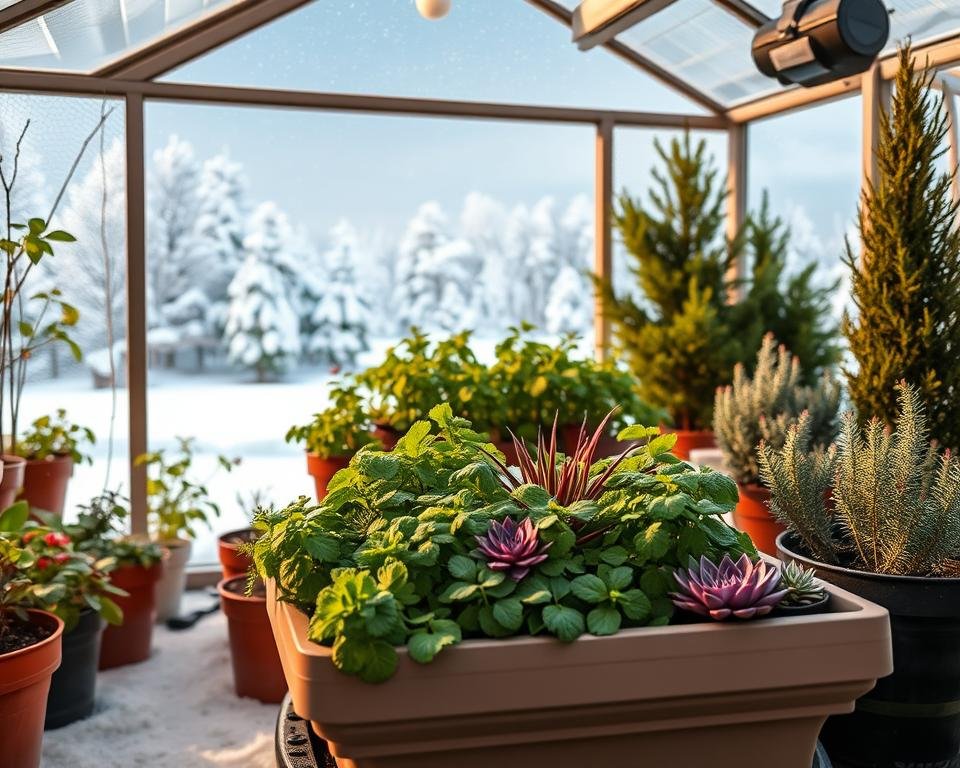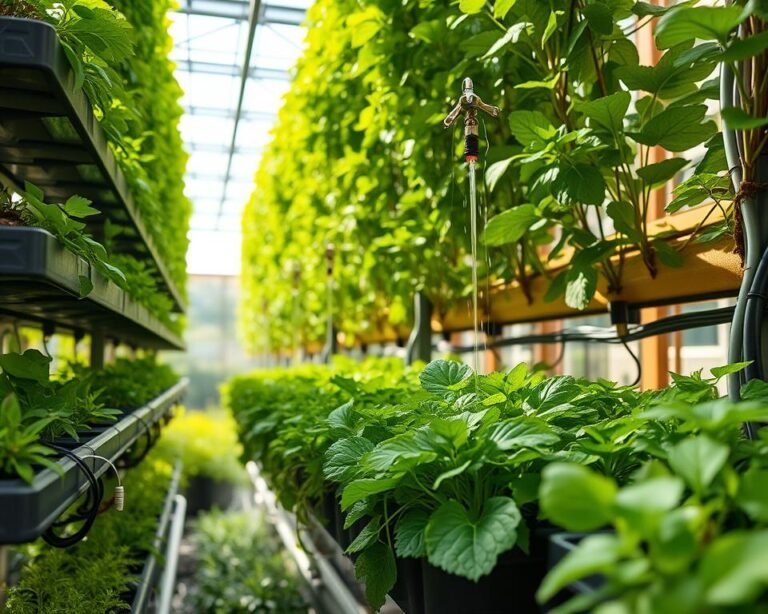Winterizing Gardens: Tips for Container Plants
As autumn winds bring change, gardeners must protect their container gardens from winter’s cold. Potted plants are more vulnerable than those in the ground. They need special care to survive the freezing temperatures.
Winterizing gardens is not just about keeping them alive. It’s also about keeping the passion and hard work you’ve put into them. Container gardens need extra care because their roots are exposed and more prone to cold damage.
This guide will show you how to winterize your container gardens. You’ll learn how to keep your plants healthy and ready for spring. We’ll cover everything from choosing the right containers to protecting them from winter’s worst.
Key Takeaways
- Container plants require specialized winter protection strategies
- Early preparation is crucial for plant survival
- Proper insulation can prevent root damage
- Different plants need different winterization approaches
- Winterizing helps maintain plant health and reduces spring replanting
Understanding Winter’s Impact on Container Gardens
Winter brings special challenges for those who garden in containers. The cold can be very hard on potted plants. This makes protecting them from frost very important.
Container plants face big risks in winter. Their roots are exposed to extreme temperatures. This can cause the soil to freeze and expand, damaging plants and containers.
Effects of Freezing Temperatures on Plant Physiology
Freezing temperatures affect plants in several ways:
- Cell walls can rupture when water inside plant tissues freezes
- Root systems become vulnerable to permanent damage
- Moisture expansion can crack even sturdy containers
- Plant metabolism slows dramatically during cold periods
Why Container Plants Need Special Protection
Container gardens need extra care in winter. They don’t have the insulation that in-ground soil provides. The exposed sides of containers make plants more likely to suffer from temperature drops. Proper garden protection strategies can mean the difference between plant survival and complete loss.
Identifying Frost-Sensitive Plants
Not all plants handle cold weather the same way. Important things to consider include:
- Check your specific USDA hardiness zone
- Research each plant’s cold tolerance
- Understand the specific needs of tropical and subtropical species
- Pay attention to plant age and maturity
By understanding these winter challenges, you can develop effective strategies to protect your container garden. This way, your plants can survive the cold season.
Selecting Winter-Hardy Containers for Cold Weather
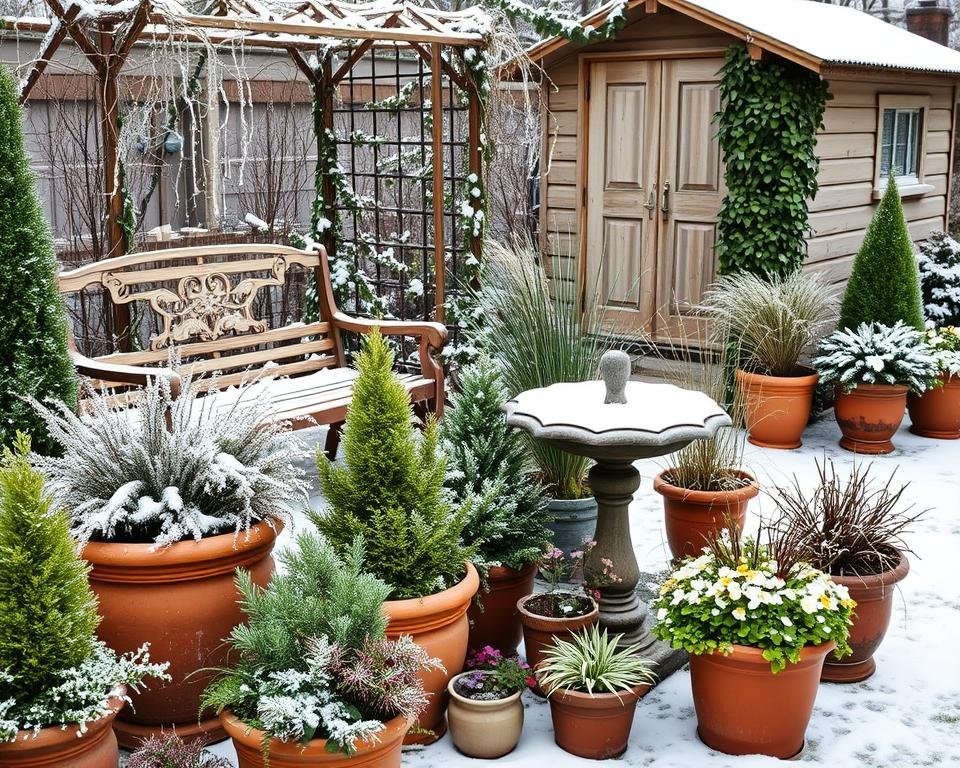
Choosing the right containers is key for cold weather gardening. The right container can help your plants survive the winter. Not all containers can handle freezing temperatures well.
For winter gardening, pick containers that can handle extreme cold. The top choices include:
- Fiberglass – lightweight and crack-resistant
- Cast Iron – extremely durable and temperature-tolerant
- Stone – naturally insulating and long-lasting
- Concrete – thick walls protect plant roots
- Heavy-duty plastic – flexible and affordable
Avoid terra cotta, ceramic, or delicate hanging baskets in winter. They can crack and don’t protect roots from freezing. Container gardening in cold climates requires strategic material choices.
In Zones 3 and 4, frost-resistant containers are a must. Containers with thick walls and minimal porosity are best. Plants in containers are more vulnerable to cold than those planted in the ground.
Pro tip: Choose containers that are at least one hardiness zone colder than your local growing zone for optimal winter plant survival.
When buying winter containers, focus on drainage. Good drainage prevents water buildup and root rot in cold months. Look for containers with multiple drainage holes and consider elevating them for better air circulation.
Winterizing Gardens: Essential Steps for Protection
Protecting your garden in winter needs careful planning and garden preparation. Knowing the key steps helps keep your plants safe from cold.
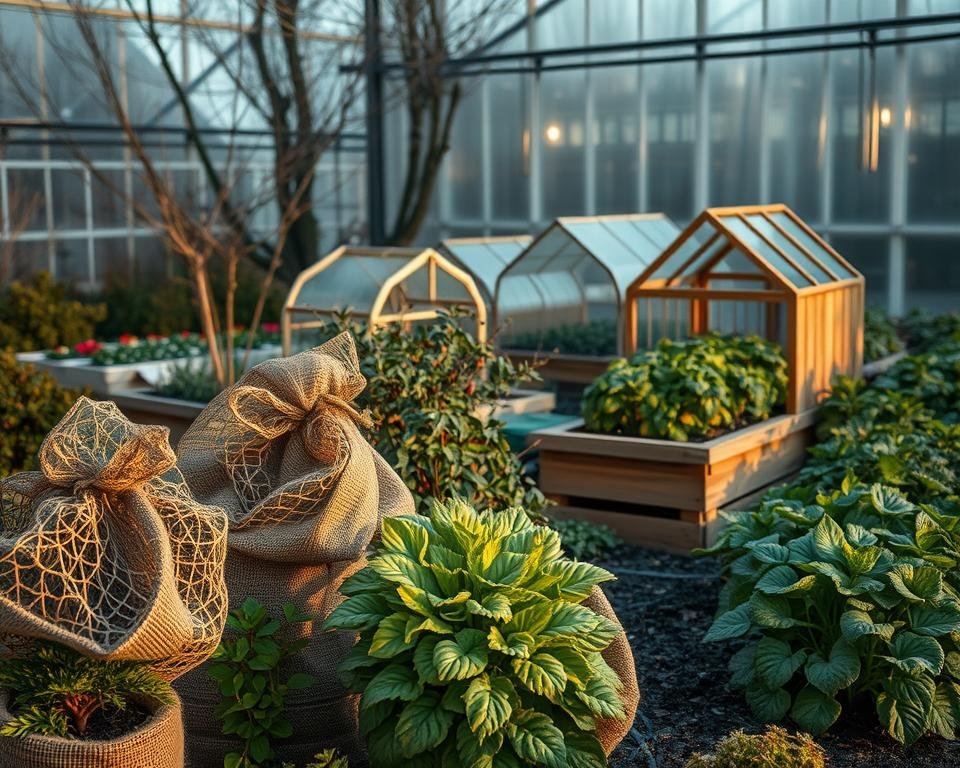
Winter can be tough on gardens. Cold temperatures can harm your plants badly. It’s important to insulate plants to keep them alive.
Soil Preparation and Drainage Solutions
Good soil care is key for winter garden protection. Here are some important tips:
- Make sure the soil drains well to avoid waterlogging
- Remove weeds to stop pests
- Water plants deeply 2-3 times a month
- Turn off irrigation systems before it freezes
Insulation Methods and Materials
Insulation helps protect plants from frost. Here are some effective methods:
- Put 2-3 inches of mulch around plants
- Use burlap or frost covers
- Create windbreaks to reduce wind damage
- Keep container plants in warm places
Timing Your Winter Preparations
Winterizing your garden takes a weekend of work. Try to finish before the first frost. Focus on protecting roots and keeping moisture in.
Remember: Proper winter care can improve spring growth by up to 20% in various plant species.
Indoor Storage Solutions for Tender Plants
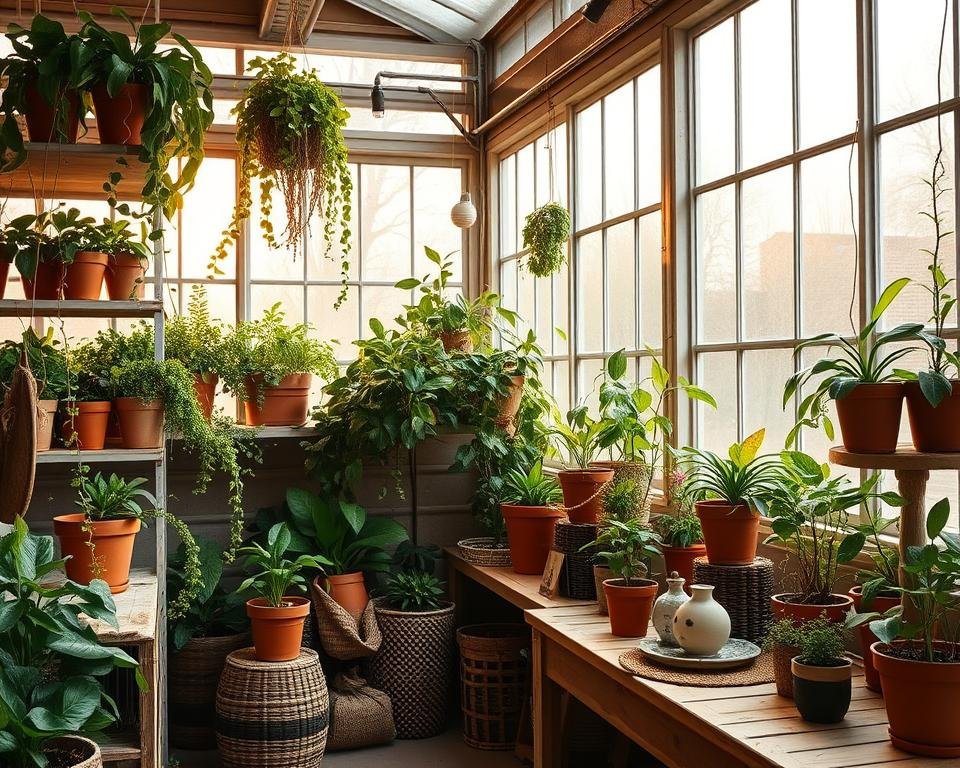
Protecting your delicate container plants during winter needs smart indoor storage. Overwintering plants can be tough, but the right steps keep your tropical and herb collections alive through the cold.
When it gets colder than 50°F, it’s time to move sensitive plants inside. Not all plants do well indoors, so picking the right ones is key for keeping them safe.
- Bring in tropical plants like citrus
- Protect herb collections such as basil, rosemary, and mint
- Select plants that can adapt to indoor environments
Before moving plants indoors, check for pests. Prune any dead or damaged foliage to prevent disease spread. Make an indoor space that feels like their natural home by considering these important points:
- Maintain consistent temperature
- Provide enough light
- Watch humidity levels
Pro tip: Limited indoor space? Consider using unheated garages or cold frames as alternative storage options for your overwintering plants.
Keep an eye on your plants and care for them well. This will help them make it through winter and be ready to go back outside when spring comes.
Outdoor Protection Strategies for Hardy Plants
Protecting your garden in winter needs careful planning. You must use protective coverings for your hardy plants. This helps shield them from cold and wind.
Mulching is key for winter garden protection. Use 2-4 inches of bark mulch, hay, or shredded leaves. This keeps roots warm and soil moist, which is great for plants like juniper.
Mulching Techniques for Root Protection
For plants in containers, use light mulch. It insulates without harming the roots. Organic mulch keeps soil moist and protects roots from temperature swings.
Using Protective Covers and Wraps
Woven fabric covers are better than plastic or paper. They protect plants when it’s cold. For evergreens, use anti-desiccant sprays to prevent moisture loss.
Creating Windbreaks and Shelters
Build natural windbreaks with plants or structures. This reduces winter damage. Avoid walking on frozen ground and gently remove snow from plants.

